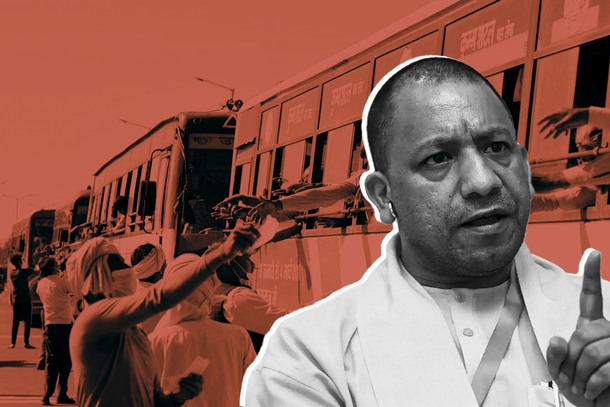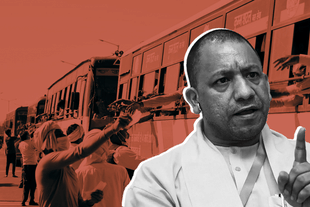Politics
Behind Yogi Adityanath’s Reforms, Industry Outreach Is The Aggressive Resolve To Not Let Migrants Coming Home Leave The State Again
Sumati Mehrishi
May 15, 2020, 01:03 PM | Updated 01:02 PM IST
Save & read from anywhere!
Bookmark stories for easy access on any device or the Swarajya app.


Uttar Pradesh Chief Minister Yogi Adityanath has stepped up his focus on uplifting the state's vibrant heritage of handicraft, artisans, and stronger support to micro small and medium enterprises (MSMEs) sector amid the challenges being thrown by the Covid-19 crises.
On 14 May, Adityanath said that out of the weighty package announced for the MSME sector by the Centre, a big chunk should come to the state. He said that this would be an "opportunity for Uttar Pradesh".
à¤à¤¦à¤°à¤£à¥à¤¯ PM शà¥à¤°à¥ @narendramodi à¤à¥ दà¥à¤µà¤¾à¤°à¤¾ à¤à¥ â¹20 लाठà¤à¤°à¥à¤¡à¤¼ à¤à¤¾ पà¥à¤à¥à¤ à¤à¥à¤·à¤¿à¤¤ हà¥à¤, à¤à¤¸à¤®à¥à¤ à¤à¥ मा. वितà¥à¤¤ मà¤à¤¤à¥à¤°à¥ शà¥à¤°à¥à¤®à¤¤à¥ @nsitharaman à¤à¥ नॠपà¥à¤à¥à¤ à¤à¥à¤·à¤¿à¤¤ à¤à¤¿à¤¯à¤¾ हà¥, à¤.पà¥à¤°. à¤à¤¾ MSME सà¥à¤à¥à¤à¤° à¤à¤¸à¤à¥ बहà¥à¤¤ बड़ॠपारà¥à¤ à¤à¥ लà¥à¤à¤° ठपनॠबड़ॠà¤à¤¬à¤¾à¤¦à¥ à¤à¥ à¤à¤¸à¤¸à¥ लाà¤à¤¾à¤¨à¥à¤µà¤¿à¤¤ à¤à¤° सà¤à¤¤à¤¾ हà¥: CM शà¥à¤°à¥ @myogiadityanath à¤à¥
— CM Office, GoUP (@CMOfficeUP) May 14, 2020
Even as the migrant workers stranded in different states continue to pour in, the Adityanath government has readied itself to welcome back the 20 lakh returning migrants with dignity, a promise for better life, and job security.
As more and more migrant workers return to the state, Adityanath's attention, evidently, is falling on the smallest of details. Not only that, his tone has begun to reflect a tougher resolve to use the talent, skills, capabilities and intangible resources living and thriving within the state and its people.
For example, he said that the artisans of Uttar Pradesh are capable and talented enough to provide better products than the ones whipped up by China.
This gave a little peep into how he might be positioning Uttar Pradesh via an opportunity through the season of Covid-19-propelled adversity.
His statement on China has come a few days after he said that along with the readymade garment industry, "a policy for perfumes, incense sticks, agricultural products, food packaging, cow-related rural products, flower-based products, and compost and fertiliser business is being formulated by the government".
He has already stated that the returning workers will be recruited for enterprise as well as the existing units.
Adityanath seems determined to use the inherent skills in the returnees to ensure that Uttar Pradesh and its people strength, remain used, evolving and celebrated through the Covid-19 period and beyond.
His mention of "China" in the statements he made on 14 May had a hint of a creative motive, solid plans, and aggression rolled into one.
Adityanath said that the world is migrating out of China and it was, in a way, the expression of the ill-feeling they have developed for China. This, he said, was owing to the hardships the world is facing due to the pandemic.
He went for more specific mentions. Taking on China, Adityanath questioned why, in these tough times, should the depictions of Gauri Ganesh (deities worshipped on Deepavali) come from China. He said, "can Gorakhpur not provide terracotta depictions instead? We will provide them (the artisans) the designs and they will prepare the depictions accordingly."
This piercing statement is not just about a chief minister of an artisan-and-soft-power-rich state mentioning Deepavali (which is months away) during a gloomy, pandemic-hit, long summer.
It is about Adityanath's sharper view on encouraging the seemingly powerless artisan (as India's original master artists appear to the handicraft-imitation industry and a stereotype-oriented media) to take on a production superpower that floods its make of depictions dear to us.
One of the vital highlights of Adityanath's statement on 14 May: his referring to the GI tag acquired by Gorakhpur terracotta products. He stressed on bringing each such product emerging from the artisans, one by one, under the umbrella of intangible heritage for encouraging artisans and for providing global recognition.
Let's not miss the local-global connection that's beginning to spill from Adityanath's own narrative amid the Covid-19 roller-coaster testing him day after day. He has already sprinted further ahead of the softpower chapter for Uttar Pradesh he created in Ayodhya for global consumption.
It is about the positioning of Uttar Pradesh — a couple of days after the Centre's announcement of collateral-free automatic loan schemes for MSME along with boosters and stimulus laden packages for the sector — as a doer in the nation's ‘localisation’ equation.
It is about pushing ahead the local economies alongside the renewed propping up of the local in Prime Minister Narendra Modi's call for “Atmanirbhar Bharat". Modi has stressed upon celebrating the local. Adityanath seems to be going three steps ahead — state to district; district to art/handicraft; art/handicraft; material.
Adityanath (in his statement made on 14 May) said that his government has provided the clay to potters free of cost. This allowed them to focus on the making of diyas and other products. This, along with the tradition of potters procuring clay from the local ponds strengthened their material and made way for the cyclic water conversation in the pond.
This author has earlier written on how on the cultural front Adityanath creates Uttar Pradesh-centric improvisations on Modi's pan India ideas, programmes and initiatives. This eventually goes on to strengthen Modi's own efforts. The two form a great ‘team culture’. Covid-19 was the least likely to see the duet evolving. Surprise. The pandemic seems to be taking it to the next level.
As the hands and sweat of Uttar Pradesh return to Uttar Pradesh, leaving behind memories of hardships, anxious travel with a hope for a future, Adityanath seems to be now gathering his bigger strengths to further enrich the state's culture. His mention of the musical instruments being made in the state (even though he mentioned only two of them in his 14 May statement) was unique.
He mentioned the making of flute, in its hub Pilibhit, and the dholak, in Amroha. He hinted at revving up this sector with new strengths to reap bigger results.
His proactive government has moved from observing to planning to policy-making, decision-making and implementation, with each passing week, back and forth between March and May.
With support from the Centre and Prime Minister Modi, Adityanath is looking at making the 'one district, one product' (announced in 2018) scheme his weapon to revitalise the MSME. There are allied people groups that power the making of the products. They, too, are set to benefit from the initiative.
Coronavirus may have posed hurdles before the initiative as of now, but Adityanath could be seen padding up his own work with the help of the specific measures announced by the Centre for MSME units in the coming months.
Adityanath has realised the state's potential during his visits to map the 'one district, one product' initiative. That's meaningful honesty — a booster for state like Uttar Pradesh to turn itself around from here.
यह निशà¥à¤à¤¿à¤¤ हॠहमारॠà¤à¤ ताà¤à¤¤ हॠà¤à¤° à¤à¤¸ ताà¤à¤¤ à¤à¥ मà¥à¤à¤¨à¥ तब महसà¥à¤¸ à¤à¤¿à¤¯à¤¾ à¤à¤¬ मà¥à¤à¥ 'वन डिसà¥à¤à¥à¤°à¤¿à¤à¥à¤, वन पà¥à¤°à¥à¤¡à¤à¥à¤' à¤à¥ à¤à¤¾à¤°à¥à¤¯à¥à¤ à¤à¥ मà¥à¤ªà¤¿à¤à¤ à¤à¥ दà¥à¤·à¥à¤à¤¿ सॠविà¤à¤¿à¤¨à¥à¤¨ à¤à¤¨à¤ªà¤¦à¥à¤ मà¥à¤ à¤à¤¾à¤¨à¥ à¤à¤¾ ठवसर पà¥à¤°à¤¾à¤ªà¥à¤¤ हà¥à¤: मà¥à¤à¥à¤¯à¤®à¤à¤¤à¥à¤°à¥ शà¥à¤°à¥ @myogiadityanath à¤à¥
— CM Office, GoUP (@CMOfficeUP) May 14, 2020
The Adityanath government has decided to brave the impact of the Covid-19 situation on the migrant workers with the help of policies to provide employment to the returning 20 lakh migrant workers and through labour reforms.
The Chief Minister, over frequent huddles with Team 11 — the core team fighting the Covid-19 situation in the state, is working towards preparing data — straight out of the quarantine centres, where the returning workers are lodged after travel and before leaving for homes.
Going back to the massive participation of artisans in making the Deepotsava (his initiative to celebrate Deepavali in Ayodhya) a success, the Chief Minister mentioned the lighting of 51,000 diyas. He said that his team had to search for the diyas across the state to procure the required number.
The number, he said, went up last year — all thanks to the consolidating of workers and artisans with the help of the ‘Maati kala board’.
What he meant to say, in all likelihood, was that the opportunity, talent and capabilities to meet the demands (and time's demands) lies with the artisans of Uttar Pradesh and these resources should be encouraged and used in the best way possible. This creates employment and gives dignity to the workers.
The diya evolution could serve as a prototype for the Covid-19-fighting Uttar Pradesh in creating employment and opportunities to the returning workers with chosen products and the involved people groups.
After Finance Minister Nirmala Sitharaman announced schemes and relief measures for the MSME sector, Adityanath reacted to the development and announced loans amounting to Rs 2,000 crore to over 36,000 MSME unit workers.
Uttar Pradesh thrives on MSME — Adityanath has said. As Covid-19 pushes the state to realise the treasure of the inherent skills, talents and capabilities of the workers who had migrated to other states in search of livelihood, the linking and inter-linking of people with different sectors could see Adityanath turn around the cultural destiny of the state to unexplored layers.
The soul-moving change in such a scenario would be to see the daily wage workers find the opportunity and the space to practise inherited skills and arts for a part of a week's work or a year's.
The toy makers, the musical instrument makers, the weavers, craftsmen, artisans, and others, can help Adityanath lighten or remove "palayan ka kalank" — the blotch of migration.
Equally important (rather more important than removing the palayan ka kalank) is giving back the returning migrants their cultural dignity at this moment. They have the material for it. It lives in them. It lives in Uttar Pradesh.





